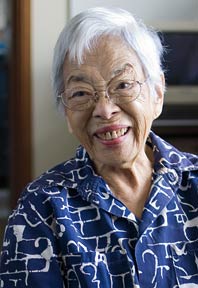Isabella Abbott facts for kids
Quick facts for kids
Dr.
Isabella Aiona Abbott
|
|
|---|---|
 |
|
| Professor of Biological Sciences, Emerita, at Stanford University | |
| Personal details | |
| Born |
Isabella Kauakea Yau Yung Aiona
20 June 1919 Hana, Maui, Territory of Hawaii |
| Died | 28 October 2010 (aged 91) Oahu, Hawaii, US |
| Spouse | Donald Putnam Abbott |
| Children | Annie Abbott Foerster, daughter |
| Alma mater | Kamehameha Schools University of Hawaiʻi at Mānoa University of Michigan University of California, Berkeley |
Isabella Aiona Abbott (June 20, 1919 – October 28, 2010) was an educator, phycologist, and ethnobotanist from Hawaii. The first native Hawaiian woman to receive a PhD in science, she became a leading expert on Pacific marine algae.
Contents
Early life
Abbott was born Isabella Kauakea Yau Yung Aiona in Hana, Maui, Territory of Hawaii, on June 20, 1919. Her Hawaiian name means "white rain of Hana" and she was known as "Izzy". Her father was ethnically Chinese while her mother was a Native Hawaiian. Her mother taught her about edible Hawaiian seaweeds and the value and diversity of Hawaii's native plants. Abbott was the only girl and second youngest in a family of eight siblings.
She grew up in Honolulu near Waikiki, and graduated from Kamehameha Schools in 1937. She received her undergraduate degree in botany at the University of Hawaiʻi at Mānoa in 1941, a master's degree in botany from the University of Michigan in 1942, and a Doctor of Philosophy in botany from the University of California, Berkeley in 1950. She married zoologist Donald Putnam Abbott (1920–1986), who had been a fellow student at the University of Hawaiʻi as well as Berkeley. The couple moved to Pacific Grove, California where her husband taught at the Hopkins Marine Station run by Stanford University. Since at that time women were rarely considered for academic posts, she spent time raising her daughter Annie Abbott Foerster, while studying the algae of the California coast. She adapted recipes to use the local bull kelp (Nereocystis) in foods such as cakes and pickles.
Career
In 1966 she became a research associate and taught as a lecturer at Hopkins. She compiled a book on marine algae of the Monterey peninsula, which later was expanded to include all of the California coast. She was awarded the Darbaker Prize by the Botanical Society of America in 1969. By 1972, Stanford University promoted her directly to full professor of Biology, where she was the first woman and first person of color in this position.
In 1982 both Abbotts retired and moved back to Hawaii, where she was hired by the University of Hawaii to teach ethnobotany, the interaction of humans and plants.
She authored eight books and over 150 publications. She was considered the world's leading expert on Hawaiian seaweeds, known in the Hawaiian language as limu. She was credited with discovering over 200 species, with several named after her, including the Rhodomelaceae family (red algae) genus of Abbottella. This earned her the nickname "First Lady of Limu."
In 1993 she received the Charles Reed Bishop Medal and in 1997 she received the Gilbert Morgan Smith Medal from the National Academy of Sciences.
She was the G. P. Wilder Professor of Botany from 1980 until her retirement in 1982, when she and her husband moved to Hawaii where she continued her research as the professor emerita of botany at the University of Hawaii. She served on the board of directors of the Bernice P. Bishop Museum. In November 1997 she co-authored an essay in the Honolulu Star-Bulletin criticizing the trustees of Kamehameha Schools, which led to its reorganization. In 1988 she was elected a fellow of the American Association for the Advancement of Science.
In 2005, she was named a Living Treasure of Hawaiʻi by the Honpa Hongwanji Mission of Hawaii.
She was considered the foremost authority on the algae of the Pacific Ocean basin and in 2008 she received a lifetime achievement award from the Hawaii Department of Land and Natural Resources for her studies of coral reefs.
The Board of Regents of the University of Hawaiʻi unanimously voted to rename the Life Sciences Building after Abbott in 2023.
Death
Isabella Kauakea Aiona Abbott died on October 28, 2010 at the age of 91 at her home in Honolulu. Abbott's surviving family includes her daughter Annie Abbott Foerster, and a granddaughter, both residing in Hawaii.
To preserve Abbott's legacy and career as a botanist, the University of Hawaiʻi established a scholarship to support graduate research in Hawaiian ethnobotany and marine botany.
See also
 In Spanish: Isabella Aiona Abbott para niños
In Spanish: Isabella Aiona Abbott para niños
- Hawaiian ethnobiology
- Timeline of women in science

